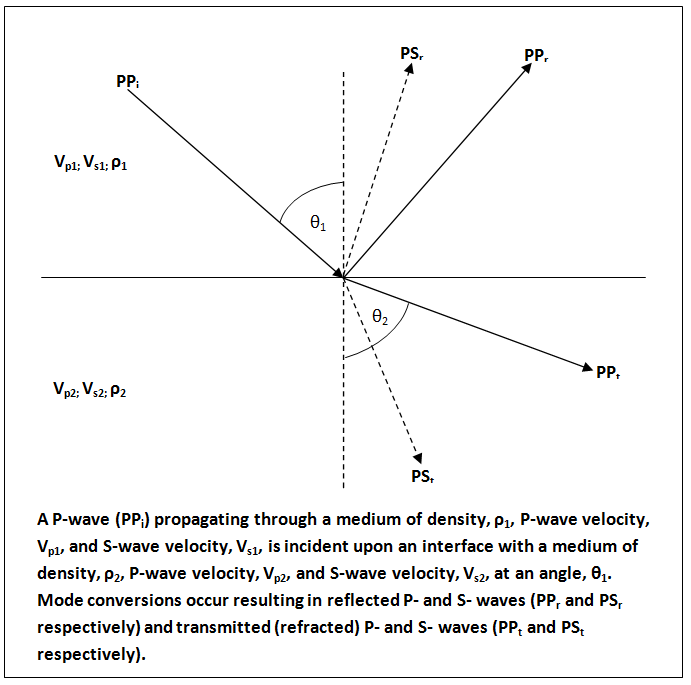|
Knott's Equations
In geophysics, Knott's equations were the first equations to describe the amplitudes of reflected and refracted waves generated at non-normal incidence upon an interface. Sheriff, R. E., Geldart, L. P., (1995), 2nd Edition. Exploration Seismology. Cambridge University Press. They were derived in 1899 by the British geophysicist Cargill Gilston Knott using displacement potential functions C. G. Knott (1899Reflection and Refraction of Elastic Waves with Seismological Applications Philosophical Magazine 48: 64–97 via Biodiversity Heritage Library and describe the same phenomenon that the Zoeppritz equations In geophysics and reflection seismology, the Zoeppritz equations are a set of equations that describe the partitioning of seismic wave energy at an interface, due to mode conversion. They are named after their author, the German geophysicist Karl ... describe in terms of amplitude displacements. References {{reflist Seismology measurement Petroleum geology ... [...More Info...] [...Related Items...] OR: [Wikipedia] [Google] [Baidu] |
Reflection At An Interface
Reflection or reflexion may refer to: Science and technology * Reflection (physics), a common wave phenomenon ** Specular reflection, reflection from a smooth surface *** Mirror image, a reflection in a mirror or in water ** Signal reflection, in signal transmission * Elastic scattering, a process in nuclear and particle physics * Reflection nebula, a nebula that is extended and has no boundaries * Reflection seismology or seismic reflection, a method of exploration geophysics Mathematics * Reflection principle, in set theory * Point reflection, a reflection across a point * Reflection (mathematics), a transformation of a space * Reflection formula, a relation in a function * Reflective subcategory, in category theory Computing * Reflection (computer graphics), simulation of reflective surfaces * Reflection (computer programming), a program that accesses or modifies its own code * Reflection, terminal emulation software by Attachmate Arts and entertainment Film and television * ... [...More Info...] [...Related Items...] OR: [Wikipedia] [Google] [Baidu] |
Geophysics
Geophysics () is a subject of natural science concerned with the physical processes and physical properties of the Earth and its surrounding space environment, and the use of quantitative methods for their analysis. The term ''geophysics'' sometimes refers only to solid earth applications: Earth's shape; its gravitational and magnetic fields; its internal structure and composition; its dynamics and their surface expression in plate tectonics, the generation of magmas, volcanism and rock formation. However, modern geophysics organizations and pure scientists use a broader definition that includes the water cycle including snow and ice; fluid dynamics of the oceans and the atmosphere; electricity and magnetism in the ionosphere and magnetosphere and solar-terrestrial physics; and analogous problems associated with the Moon and other planets. Gutenberg, B., 1929, Lehrbuch der Geophysik. Leipzig. Berlin (Gebruder Borntraeger). Runcorn, S.K, (editor-in-chief), 1967, International ... [...More Info...] [...Related Items...] OR: [Wikipedia] [Google] [Baidu] |
Cargill Gilston Knott
Cargill Gilston Knott FRS, FRSE LLD (30 June 1856 – 26 October 1922) was a Scottish physicist and mathematician who was a pioneer in seismological research. He spent his early career in Japan. He later became a Fellow of the Royal Society, Secretary of the Royal Society of Edinburgh, and President of the Scottish Meteorological Society. Biography Knott was born in Penicuik, Midlothian, the son of Pelham Knott, an agent for a paper manufacturer and his wife Ellen. His paternal uncle was the artist Tavernor Knott. He was educated at Arbroath High School in Angus, and attended the University of Edinburgh, where he studied alongside James Alfred Ewing. He worked on various aspects of electricity and magnetism, obtaining his doctorate in 1879. He was appointed as an assistant in Natural Philosophy at the University of Edinburgh in 1879, and held this post until 1883, when he left to take up a post at Tokyo Imperial University. He was elected as a Fellow of the Royal Society of ... [...More Info...] [...Related Items...] OR: [Wikipedia] [Google] [Baidu] |
Philosophical Magazine
The ''Philosophical Magazine'' is one of the oldest scientific journals published in English. It was established by Alexander Tilloch in 1798;John Burnett"Tilloch, Alexander (1759–1825)" Oxford Dictionary of National Biography, Oxford University Press, Sept 2004; online edn, May 2006, accessed 17 Feb 2010 in 1822 Richard Taylor became joint editor and it has been published continuously by Taylor & Francis ever since. Early history The name of the journal dates from a period when "natural philosophy" embraced all aspects of science. The very first paper published in the journal carried the title "Account of Mr Cartwright's Patent Steam Engine". Other articles in the first volume include "Methods of discovering whether Wine has been adulterated with any Metals prejudicial to Health" and "Description of the Apparatus used by Lavoisier to produce Water from its component Parts, Oxygen and Hydrogen". 19th century Early in the nineteenth century, classic papers by Humphry Davy, M ... [...More Info...] [...Related Items...] OR: [Wikipedia] [Google] [Baidu] |
Biodiversity Heritage Library
The Biodiversity Heritage Library (BHL) is the world’s largest open access digital library for biodiversity literature and archives. BHL operates as worldwide consortiumof natural history, botanical, research, and national libraries working together to address this challenge by digitizing the natural history literature held in their collections and making it freely available for open access as part of a global “biodiversity community.” The BHL consortium works with the international taxonomic community, publishers, bioinformaticians, and information technology professionals to develotools and servicesto facilitate greater access, interoperability, and reuse of content and data. BHL provides a range of services, data exports, and APIs to allow users to download content, harvest source data files, and reuse materials for research purposes. Through taxonomic intelligence tools developed bGlobal Names Architecture BHL indexes the taxonomic names throughout the collection, allowing ... [...More Info...] [...Related Items...] OR: [Wikipedia] [Google] [Baidu] |
Zoeppritz Equations
In geophysics and reflection seismology, the Zoeppritz equations are a set of equations that describe the partitioning of seismic wave energy at an interface, due to mode conversion. They are named after their author, the German geophysicist Karl Bernhard Zoeppritz, who died before they were published in 1919. The equations are important in geophysics because they relate the amplitude of P-wave, incident upon a plane interface, and the amplitude of reflected and refracted P- and S-waves to the angle of incidence.Sheriff, R. E., Geldart, L. P., (1995), 2nd Edition. Exploration Seismology. Cambridge University Press. They are the basis for investigating the factors affecting the amplitude of a returning seismic wave when the angle of incidence is altered — also known as amplitude versus offset analysis — which is a helpful technique in the detection of petroleum reservoirs. The Zoeppritz equations were not the first to describe the amplitudes of reflected and refracted waves ... [...More Info...] [...Related Items...] OR: [Wikipedia] [Google] [Baidu] |
Seismology Measurement
Seismology (; from Ancient Greek σεισμός (''seismós'') meaning "earthquake" and -λογία (''-logía'') meaning "study of") is the scientific study of earthquakes and the propagation of elastic waves through the Earth or through other planet-like bodies. It also includes studies of earthquake environmental effects such as tsunamis as well as diverse seismic sources such as volcanic, tectonic, glacial, fluvial, oceanic, atmospheric, and artificial processes such as explosions. A related field that uses geology to infer information regarding past earthquakes is paleoseismology. A recording of Earth motion as a function of time is called a seismogram. A seismologist is a scientist who does research in seismology. History Scholarly interest in earthquakes can be traced back to antiquity. Early speculations on the natural causes of earthquakes were included in the writings of Thales of Miletus (c. 585 BCE), Anaximenes of Miletus (c. 550 BCE), Aristotle (c. 340 BCE), and Zhan ... [...More Info...] [...Related Items...] OR: [Wikipedia] [Google] [Baidu] |




